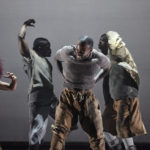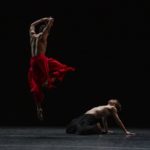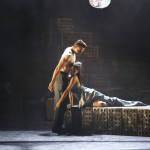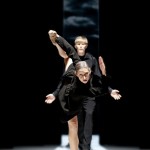Andrew Blackmore reports from The Joyce Theater in New York:
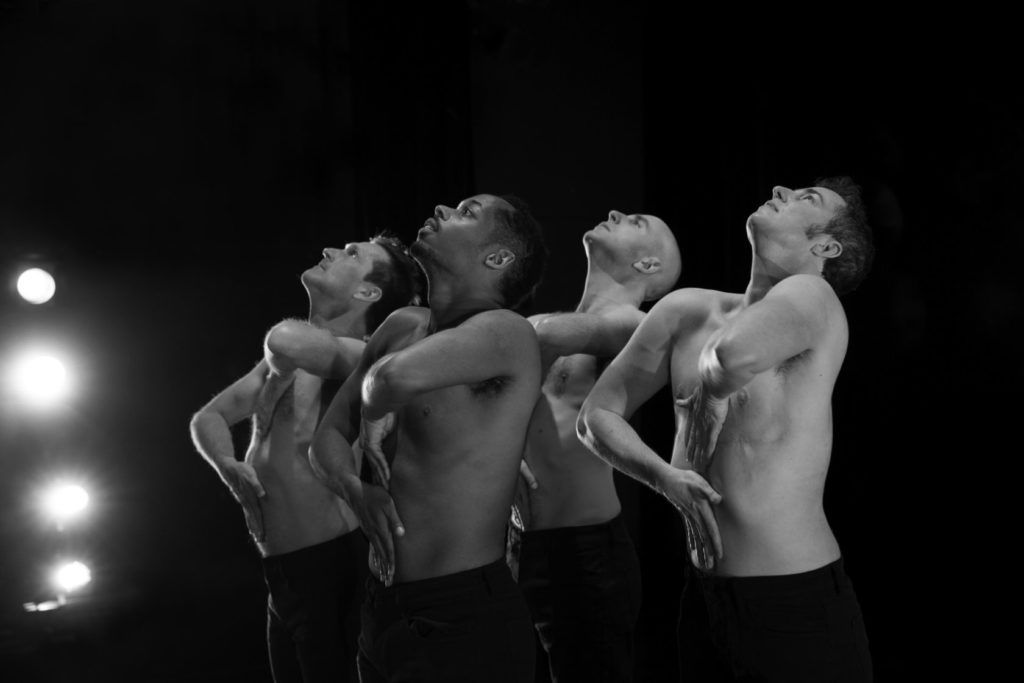
l-r: Brian Fisher, ArVejon Jones, Nol Simonse, Sean Dorsey of Sean Dorsey Dance in Dorsey’s The Missing Generation (photo: Lydia Daniller)
Pride Week in New York City was the ideal time for Sean Dorsey to be the first transgender choreographer to present a show at The Joyce Theater. This is also the first Pride Week at The Joyce, a festival of dance celebrating the LGBTQ community,which made it a significant occasion. Dorsey’s show, The Missing Generation, is the product of two years of research during which he gathered testimonials from survivors of the AIDS epidemic that decimated gay communities across the country in the 80s. The motivating concern is that not enough people today are fully aware of what he perceives as a lost generation of survivors. They are a traumatized generation who survived a calamity that only a few remember or understand today. Dorsey’s aim is to remind us that they are still here and they need us to remember and acknowledge them.
Most people think of the 1969 Stonewall riots as the genesis of the gay community’s political identity, but I think the community only really began to develop and flex its political muscle when it became clear that the Reagan administration was never going to acknowledge the AIDS crisis that was killing gay and transgender people with frightening speed and frequency. It was a time of such terrible stress and upheaval that it forced everyone to do whatever they could to help one another. Gay Men’s Health Crisis was formed to begin organizing the community and give people help. Individuals began organizing on a level not seen before and delivered food to people who were going hungry. ACT UP took to the streets and confronted the government with public protests. Artists like Keith Haring created a powerful identity, and from all this, a movement was born. It’s because of that period that the LGBTQ community now recognizes itself as a potent political and economic force. To see this year’s Pride Parade was to witness a powerful statement of the LGBTQ community’s clout. All the politicians showed up.
For this work, Dorsey collected the stories and wove them together into an hour-long performance that pays homage to those who died and those who survived. It informs while offering comfort and is never less than compassionate. The score is part music and part testimonial along with some monologues spoken by the cast. Brian Fisher spoke about the draw of the big city for young gay men and the explosion of nightlife in the 70s. We heard about life along the fringe in the transgender community. The most potent testimonials took us through the memories of people slowly becoming aware that they were under siege from a terrible disease that made them modern-day lepers. It began with people getting mysteriously ill, losing weight and developing the tumors that became known as Kaposi’s sarcoma. One week a friend would be there and the next week gone. Some described the process of shutting their emotional lives down to survive the weekly horror of funerals.
Dorsey, along with Brian Fisher, Nol Simonse and ArVejon Jones danced individually, in pairs and collectively to express the various ways in which people were affected. The dancing was emotionally resonant. Dorsey’s style is not technically demanding but rather organic, with a natural flow. The jumps are light and the landings soft. The quartet danced individually and as an ensemble, always moving with a feeling of freedom. You won’t see anything astonishing but that’s beside the point. The choreography manages to capture the sense of drawing together, the sharing of comfort, and the despair that made it necessary.
There’s not much more to be said about this work as it must be experienced in order to receive its message. It is not about virtuoso dancing or impressive patterns. The show has been on tour in the U.S. and is a must-see for anyone who lived through those times or would like to understand what happened.


